Victoria Alarcon
Sports & Health Editor
It was the kind of decision no one wants to have to make, but Amy Purdy was forced to make it, to say ‘yes’ to a decision that would save her life while at the same time completely alter it.
“It was very hard to wrap my head around,” Purdy admitted. “It was sad, it was heartbreaking, but it had to happen.” “It was the only way to save my life.” Up until that point, the Las Vegas-born Purdy had everything going for her; an athlete at heart, she split most of her time between the gym and the ski slopes, exercising her in- credible talent for competitive snowboarding and satisfying her love for the outdoors.
At 19, Purdy came down with bacterial meningitis, and things began to take a turn for the worse.
“Within 15 hours I was in the hospital on life support, and ended up going into a coma. It took them five days to figure out that I had meningitis,” Purdy can still recall the details of her diagnosis. “I was given less than a two percent chance of living.”
Her family stood by and watched as three months went by and Purdy lost her kidney functions, the hearing in her left ear and a part of her left lung. The hardest blow came when the doctors told her they would have to amputate both her legs just below the knee.
She knew this meant she’d soon face a host of obstacles on a daily basis, but Purdy felt giving up was never an option.
“I decided right before they took my legs, my life is absolutely not going to stop because of this. I’m going to keep moving forward and keep doing the things I love to do,” she promised herself.
Seven months later, Purdy was back on a snowboard, learning how to move with her new prosthetic legs. She fought through her sickness and the meningitis, which had left her at a mere 80 pounds. She pushed past the frustration of her condition and the challenge the prosthetic legs proved to be.
The complications that plagued her over much of the next few months only made her more determined. With confidence, Amy decided to enter her first snowboarding competition – one year after she lost her legs – with no regard for the outcome.
“I didn’t care if nobody had ever heard of a double amputee snowboarder and I didn’t care if people said I would not be able to walk any more,” Purdy reflects.
She placed third in the competition.
Purdy soon entered more snowboarding contests, both national and international.
Purdy fulfilled the promise she made to herself, and, as she tried out different prostheses, she began to explore other activities. She began modeling for numerous agencies, most of whom encouraged her to show off her prosthetic legs. Purdy even appeared in a Madonna video – she played a runway model with metal legs – and tried acting, making her debut in the film What’s Bugging Seth in 2005.
Purdy has also taken up wakeboarding and skateboarding.
Her newfound success gave her the motivation to help those who were undergoing the same challenges she had gone through a year prior. She realized many individuals lacked the support to succeed in action sports like she had, primarily because of excessive costs and a need for special equipment.
That’s why Purdy decided to start Adaptive Action Sports, an organization for people who wanted to learn how to snowboard, skateboard or motocross in spite of their disabilities. Those looking for some kind of hope now had a place to find it.
Outside of her work with AAS, Purdy has also put a lot of effort into making snowboarding a part of the Paralympic Games, a sport that’s long been missing from the competition.
“We are working on putting a world championship together to get the support of the Paralympics,” she remarked. “I know even more viewers will be inspired and want to be part of the games if they included it.”
As a motivational speaker, Purdy is used to giving advice, so she knew exactly what to say when I asked her what she wanted to pass on to York students. In a few short sentences she summed up the philosophy she’d applied to the past few years of her life.
“It’s about not giving up. I think everything in life is a choice. You make the choice of which direction you’re going to go in life,” said Purdy. “You may come across tons of obstacles and competition in your life, but you should use all of that to motivate you to go where you want to be. Let each obstacle give you strength to move forward.”




